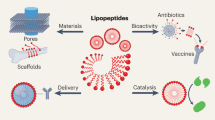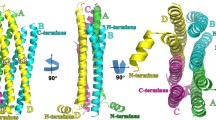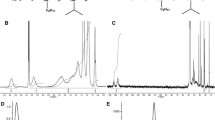Abstract
Self-assembling amphipathic peptides (SAPs) are a category of peptides that have unique sequences with alternating hydrophobic and hydrophilic residues that can spontaneously assemble into ordered nanostructures. In this study, we investigated the potential of fusion technique with SAPs to improve the thermal stability of lipoxygenase (LOX) from Pseudomonas aeruginosa. Six SAPs were individually fused to the N terminus of the LOX that resulted to the SAP–LOX fusions with approximately 2.3- to 4.5-fold enhanced thermal stability at 50 °C. The specific activities of the SAP–LOX fusions were also increased by 1.0- to 2.8-fold as compared with the wild-type LOX. This is the first report on the improvement of the thermal stability and specific activity of an enzyme by the fused SAPs, suggesting a simple technique to improve the catalytic properties of the recombinant enzymes by fusion expression.






Similar content being viewed by others
References
Bommarius AS, Blum JK, Abrahamson MJ (2011) Status of protein engineering for biocatalysts: how to design an industrially useful biocatalyst. Curr Opin Chem Biol 15:194–200
Bradford MM (1976) A rapid and sensitive method for the quantitation of microgram quantities of protein utilizing the principle of protein-dye binding. Anal Biochem 72:248–254
Busquets M, Deroncele V, Vidal-Mas J, Rodriguez E, Guerrero A, Manresa A (2004) Isolation and characterization of a lipoxygenase from Pseudomonas 42A2 responsible for the biotransformation of oleic acid into ( S )-( E )-10-hydroxy-8-octadecenoic acid. Anton Leeuw Int J G 85:129–139
Casey R, Hughes RK (2004) Recombinant lipoxygenases and oxylipin metabolism in relation to food quality. Food Biotechnol 18:135–170
Clantin B, Tricot C, Lonhienne T, Stalon V, Villeret V (2001) Probing the role of oligomerization in the high thermal stability of Pyrococcus furiosus ornithine carbamoyltransferase by site-specific mutants. Eur J Biochem 268:3937–3942
Damm KL, Carlson HA (2006) Gaussian-weighted RMSD superposition of proteins: a structural comparison for flexible proteins and predicted protein structures. Biophys J 90:4558–4573
Fenel F, Leisola M, Janis J, Turunen O (2004) A de novo designed N-terminal disulphide bridge stabilizes the Trichoderma reesei endo-1,4-beta-xylanase II. J Biotechnol 108:137–143
Fung SY, Yang H, Bhola PT, Sadatmousavi P, Muzar E, Liu M, Chen P (2009) Self-assembling peptide as a potential carrier for hydrophobic anticancer drug ellipticine: complexation, release and in vitro delivery. Adv Funct Mater 19:74–83
Gao Y, Zhao F, Wang Q, Zhang Y, Xu B (2010) Small peptide nanofibers as the matrices of molecular hydrogels for mimicking enzymes and enhancing the activity of enzymes. Chem Soc Rev 39:3425–3433
Gardner HW (1996) Lipoxygenase as a versatile biocatalyst. J Am Oil Chem Soc 73:1347–1357
Ge J, Lu D, Yang C, Liu Z (2011) A lipase-responsive vehicle using amphipathic polymer synthesized with the lipase as catalyst. Macromol Rapid Comm 32:546–550
Hughes RK, Wu Z, Robinson DS, Hardy D, West SI, Fairhurst SA, Casey R (1998) Characterization of authentic recombinant pea-seed lipoxygenases with distinct properties and reaction mechanisms. Biochem J 333:33–43
Iwakura M, Honda S (1996) Stability and reversibility of thermal denaturation are greatly improved by limiting terminal flexibility of Escherichia coli dihydrofolate reductase. J Biochem 119:414–420
Jasniewski J, Cailliez-Grimal C, Chevalot I, Millière JB, Revol-Junelles AM (2009) Interactions between two carnobacteriocins Cbn BM1 and Cbn B2 from Carnobacterium maltaromaticum CP5 on target bacteria and Caco-2 cells. Food Chem Toxicol 47:893–897
Joshi M, Adhikari B, Aldred P, Panozzo J, Kasapis S, Barrow C (2012) Interfacial and emulsifying properties of lentil protein isolate. Food Chem 143:1343–1353
Kannan N, Vishveshwara S (2000) Aromatic clusters: a determinant of thermal stability of thermophilic proteins. Protein Eng 13:753–761
Kato A, Nakai S (1980) Hydrophobicity determined by a fluorescence probe method and its correlation with surface properties of proteins. Biochim Biophys Acta 624:13–20
Kermasha S, Dioum N, Bisakowski B (2001) Biocatalysis of lipoxygenase in selected organic solvent media. J Mol Catal B-Enzym 11:909–919
Koutsopoulos S, Kaiser L, Eriksson HM, Zhang S (2012) Designer peptide surfactants stabilize diverse functional membrane proteins. Chem Soc Rev 41:1721–1728
Kuzmanic A, Zagrovic B (2010) Determination of ensemble-average pairwise root mean-square deviation from experimental B-factors. Biophys J 98:861–871
Laemmli UK (1970) Cleavage of structural proteins during the assembly of the head of bacteriophage T4. Nature 227:680–685
Lazar KL, Miller-Auer H, Getz GS, Orgel JP, Meredith SC (2005) Helix-turn-helix peptides that form alpha-helical fibrils: turn sequences drive fibril structure. Biochemistry 44:12681–12689
Leemhuis H, Rozeboom HJ, Dijkstra BW, Dijkhuizen L (2004) Improved thermostability of Bacillus circulans cyclodextrin glycosyltransferase by the introduction of a salt bridge. Proteins 54:128–134
Lu X, Zhang J, Liu S, Zhang D, Xu Z, Wu J, Li J, Du G, Chen J (2012) Overproduction, purification, and characterization of extracellular lipoxygenase of Pseudomonas aeruginosa in Escherichia coli. Appl Microbiol Biot. doi:10.1007/s00253-012-4457-6
Machius M, Declerck N, Huber R, Wiegand G (2003) Kinetic stabilization of Bacillus licheniformis α-amylase through introduction of hydrophobic residues at the surface. J Biol Chem 278:11546–11553
Maniatis T (1989) Molecular cloning: a laboratory manual/J. Sambrook, EF Fritsch, T. Maniatis. New York: Cold Spring Harbor Laboratory PressS
Matsumoto K, Vaughn M, Bruce BD, Koutsopoulos S, Zhang S (2009) Designer peptide surfactants stabilize functional photosystem-I membrane complex in aqueous solution for extended time. J Phys Chem B 113:75–83
Matsuura T, Miyai K, Trakulnaleamsai S, Yomo T, Shima Y, Miki S, Yamamoto K, Urabe I (1999) Evolutionary molecular engineering by random elongation mutagenesis. Nat Biotechnol 17:58–61
Mishra A, Loo Y, Chuah RDYJ, Heeb H, Ying J, Hauser C (2011) Ultrasmall natural peptides self-assemble to strong temperature-resistant helical fibers in scaffolds suitable for tissue engineering. Nano Today 6:232–239
Ó’Fágáin C (2003) Enzyme stabilization—recent experimental progress. Enzyme Microb Tech 33:137–149
Pearce FG, Dobson RC, Jameson GB, Perugini MA, Gerrard JA (2011) Characterization of monomeric dihydrodipicolinate synthase variant reveals the importance of substrate binding in optimizing oligomerization. Biochim Biophys Acta 1814:1900–1909
Reddy GB, Bharadwaj S, Surolia A (1999) Thermal stability and mode of oligomerization of the tetrameric peanut agglutinin: a differential scanning calorimetry study. Biochemistry 38:4464–4470
Reetz MT, Carballeira JD, Vogel A (2006) Iterative saturation mutagenesis on the basis of B factors as a strategy for increasing protein thermostability. Angew Chem Int Ed Engl 45:7745–7751
Schoch GA, Attias R, Belghazi M, Dansette PM, Werck-Reichhart D (2003) Engineering of a water-soluble plant cytochrome P450, CYP73A1, and NMR-based orientation of natural and alternate substrates in the active site. Plant Physiol 133:1198–1208
Soliman W, Bhattacharjee S, Kaur K (2010) Adsorption of an antimicrobial peptide on self-assembled monolayers by molecular dynamics simulation. J Phys Chem B 114:11292–11302
Takano K, Okamoto T, Okada J, Tanaka S, Angkawidjaja C, Koga Y, Kanaya S (2011) Stabilization by fusion to the C-terminus of hyperthermophile Sulfolobus tokodaii RNase HI: a possibility of protein stabilization tag. PLoS One 6:e16226
Tanaka Y, Tsumoto K, Yasutake Y, Umetsu M, Yao M, Fukada H, Tanaka I, Kumagai I (2004) How oligomerization contributes to the thermostability of an archaeon protein: protein l-isoaspartyl-o-methyltransferase from Sulfolobus toloda II. J Biol Chem 279:32957–32967
Tendeng C, Krin E, Soutourina OA, Marin A, Danchin A, Bertin PN (2003) A novel H-NS-like protein from an antarctic psychrophilic bacterium reveals a crucial role for the N-terminal domain in thermal stability. J Biol Chem 278:18754–18760
Vance R, Hong S, Gronert K, Serhan C, Mekalanos J (2004) The opportunistic pathogen Pseudomonas aeruginosa carries a secretable arachidonate 15-lipoxygenase. P Natl Acad Sci USA 101:2135
Vega M, Karboune S, Kermasha S (2005) Stability of immobilized soybean lipoxygenase in selected organic solvent media. Appl Biochem Biotechnol 127:29–42
Vieille C, Zeikus GJ (2001) Hyperthermophilic enzymes: sources, uses, and molecular mechanisms for thermostability. Microbiol Mol Biol R 65:1–43
Wang Q, Yang Z, Gao Y, Ge W, Wang L, Xu B (2008) Enzymatic hydrogelation to immobilize an enzyme for high activity and stability. Soft Matter 4:550–553
Wang X, Corin K, Baaske P, Wienken CJ, Jerabek-Willemsen M, Duhr S, Braun D, Zhang S (2011) Peptide surfactants for cell-free production of functional G protein-coupled receptors. P Natl Acad Sci USA 108:9049–9054
Whitmore L, Wallace BA (2004) DICHROWEB, an online server for protein secondary structure analyses from circular dichroism spectroscopic data. Nucleic Acids Res 32:W668–673
Whitmore L, Wallace BA (2008) Protein secondary structure analyses from circular dichroism spectroscopy: methods and reference databases. Biopolymers 89:392–400
Wu W, Xing L, Zhou B, Lin Z (2011) Active protein aggregates induced by terminally attached self-assembling peptide ELK16 in Escherichia coli. Microb Cell Fact 10:9
Yang H, Fung SY, Pritzker M, Chen P (2007) Modification of hydrophilic and hydrophobic surfaces using an ionic-complementary peptide. PLoS One 2:e1325
Yeh JI, Du S, Tortajada A, Paulo J, Zhang S (2005) Peptergents: peptide detergents that improve stability and functionality of a membrane protein, glycerol-3-phosphate dehydrogenase. Biochemistry 44:16912–16919
Zhang S, Lockshin C, Herbert A, Winter E, Rich A (1992) Zuotin, a putative Z-DNA binding protein in Saccharomyces cerevisiae. EMBO J 11:3787
Zhang S, Holmes T, Lockshin C, Rich A (1993) Spontaneous assembly of a self-complementary oligopeptide to form a stable macroscopic membrane. P Natl Acad Sci USA 90:3334–3338
Acknowledgments
We would like to thank Professor Byong H. Lee for critical reading and suggestions on the manuscript. This work was supported by the National Natural Science Foundation of China (no. 31171639, no. 31000031, and no. 31070711), the National High Technology Research and Development Program of China (No. 2011AA100905), the NCET-10-0461, the Natural Science Foundation of Jiangsu Province (No. BK2010147), and the Independent Innovation Program of Jiangnan University (JUSRP11215).
Author information
Authors and Affiliations
Corresponding authors
Rights and permissions
About this article
Cite this article
Lu, X., Liu, S., Zhang, D. et al. Enhanced thermal stability and specific activity of Pseudomonas aeruginosa lipoxygenase by fusing with self-assembling amphipathic peptides. Appl Microbiol Biotechnol 97, 9419–9427 (2013). https://doi.org/10.1007/s00253-013-4751-y
Received:
Revised:
Accepted:
Published:
Issue Date:
DOI: https://doi.org/10.1007/s00253-013-4751-y




